The Sedai Oral History Collection is committed to collecting, documenting, preserving and sharing the history of Japanese Canadians. Sedai collects and preserves Japanese Canadian history through audio and video recordings, and continues to add to the collection.
For uses other than research or private study, please submit a request to heritage@jccc.on.ca.
Feature of the month
On the 80th Anniversary of the bombing of Hiroshima, Sedai features Nobel Peace Prize laureate Setsuko Thurlow. Thurlow was only 13 when the atomic bomb devastated Hiroshima and buried her in rubble. A lifelong advocate for peace and nuclear disarmament, she continues to share her story.
Date: October 29, 2010
Interviewer: Lisa Uyeda
Powell Street was the beating heart of the Japanese Canadian community before World War II, full of Japanese Canadian businesses, institutions, and homes. Our Sedai feature this month highlights memories of Powell Street in that era.
Powell Street is still an important gathering place for Japanese Canadians, having played host the the Powell Street Festival for nearly 50 years. The 2025 festival runs from August 2nd and 3rd! https://powellstreetfestival.com/
Featured interviewees:
Frank Tadao Shimada (2011.217)
Terry Idenouye (2012.194)
Laiko Matsubayashi (2010.049)
Pat Adachi (2011.349)
Miyo Nakamura (2011.021)
Learn more about the interviewees: https://jccc.on.ca/sedai-catalogue
Archival images (in order of appearance):
Statement from S. Shibuya Co. JCCC, Bess (Nakazawa) Tateishi Collection, 2021.50.01.01
The New Canadian, December 7, 1939, page 5. Courtesy of the Multicultural Historical Society of Ontario.
Mrs. Yamake in Kasuga Kashiya (Candy Shop), 1938. JCCC Original Photographic Collection, 2001.4.018.
The Powell Street Children's Foot Race, 1941. JCCC Tom Matsui Collection, 2011.47.06.09.05.
Scene on Powell Street, featuring Fuji Chop Suey, ca. 1940. JCCC Original Photographic Collection, 2011.15.110
For Asian Heritage Month, Sedai features Stony Tsutomo Nakano, who recounts the start of his decades-long friendship with Tak Ho, a Chinese Canadian, which started on a 1971 bus trip from Toronto to Lethbridge.
Date: August 31st, 2010
Interviewer: Lisa Uyeda
March 8th marks International Women’s Day. In honour of this, Sedai’s March feature is of Joanne Sugiyama, who discusses her grandmother's "proto-feminism" and her father's encouragement of her abilities. She reflects on the contributions of women in the Japanese Canadian community and how her feminist attitude influenced her children and grandchildren.
Date: December 27th, 2013
Interviewer: Elizabeth Fujita-Kwan & Katharine Fish
For more information on Joanne's story, please see her entry on the Sedai Catalogue: https://jccc.on.ca/sedai-catalogue/2013361/interview-joanne-sugiyama
This Valentine's Day, Sedai features Fumiko Kanbara, who recounts how she met her husband -- who was her former Japanese teacher. Though engaged, Fumiko and her husband Tameo were separated during WWII: Tameo was placed in the POW camp at Angler, while Fumiko was interned in Slocan and New Denver. They later married in 1946 in Hamilton and settled there.
Date: October 30th, 2011
Interviewer: Lisa Uyeda
This month, Sedai features Hisako Shin Shinkoda, who, unable to go to university after high school, managed to get a BA from the University of Toronto at age 80.
Date: July 19th, 2010
Interviewer: Lisa Uyeda
For more information on Hisako's story, please see his entry on the Sedai Catalogue: https://jccc.on.ca/sedai-catalogue/2010038/interview-hisako-shin-shinkoda
This month, Sedai features an interview with Roy Nagamatsu, who discusses his work at the hospital at Hastings Park and later, at the tuberculosis sanatorium in New Denver. Due to his work, he was one of the last Japanese Canadians left in Vancouver before the sanatorium at New Denver was complete in 1943.
Date: November 11, 2010
Interviewer: Lisa Uyeda
For more information on Roy Nagamatsu's story, please see his entry on the Sedai catalogue: https://jccc.on.ca/sedai-catalogue/2010074/interview-roy-akira-nagamatsu
This month, Sedai features an interview with Gloria and Mits Sumiya. Mits Sumiya, who was allowed to finish his first year at the University of British Columbia at the time of forced uprooting, questioned why he was being sent to a road camp. In this clip, he recalls how he and other men considered prisoners of war were kept in an immigration building in Vancouver before being transferred to Angler Prisoner of War camp in Ontario.
Date: September 16th, 2010
Interviewer: Lisa Uyeda
For more information on Gloria and Mits Sumiya's story, please see their entry on the Sedai catalogue: https://jccc.on.ca/sedai-catalogue/2010062/interview-gloria-and-mits-sumiya
This month, Sedai features Thomas Matsui, who recalls how Japanese Canadians displaced to Toronto in the 1940s were welcomed in the United Church. He further reflects on how churches encouraged conversion to Christianity from Buddhism and Shinto in Vancouver by teaching English to the nisei.
Date: March 16th, 2011
Interviewer: Lisa Uyeda
For more information on Thomas Matsui's story, please see his entry on the Sedai catalogue: jccc.on.ca/sedai-catalogue/2011047/interview-thomas-matsui
This month, Sedai features an interview with Harold Miwa, who played baseball in Fort William, Ontario after being interned at Tashme. His hopes to playing baseball south of the border in 1947 were dashed by wartime policies which deemed Japanese Canadians to be enemy aliens. Years later, his daughter would go on to earn a scholarship for her talent in baseball.
Date: October 6th & 20th, 2011
Interviewer: Lisa Uyeda
Videographer: Lisa Uyeda
For more information on Harold's story, please see his entry on the Sedai Catalogue: jccc.on.ca/sedai-catalogue/2011279/interview-harold-miwa
This month, Sedai features David Azuma, who discusses being sent to Japan for his education as a child. Unable to return during the war, David returned to Toronto in 1949 and started a club for fellow Japanese Canadian 'returnees'.
Date: June 16th, 2010
Interviewer: Lisa Uyeda
For more information on David's story, please see his entry on the Sedai Catalogue: https://jccc.on.ca/sedai-catalogue/2010028/interview-david-azuma
This month, Sedai features Elsie Toguri, who remembers her mother, Midori Iwasaki, the manager of Tairiku Nippon, a Japanese-language newspaper published in Vancouver between 1902 and December 1941. Midori Iwasaki was a woman "before her time", who, in addition to running Tairiku Nippon, helped Japanese women in the community.
Date: February 4th, 2013
Interviewer: Elizabeth Fujita-Kwan
For more information on Elsie's story, please see his entry on the Sedai Catalogue: https://jccc.on.ca/sedai-catalogue/2013035/interview-elsie-toguri-nee-iwasaki
This month, Sedai features Frank Moritsugu, a nisei WWII veteran and one of the first Japanese Canadian journalists to write for mainstream publications. Here, he discusses the diversity of Japanese dialects found in pre-war Vancouver and his experience with his heritage language as a child of immigrants.
Date: June 18th, 2010
Interviewer: Lisa Uyeda
For more information on Frank's story, please see his entry on the Sedai Catalogue: jccc.on.ca/sedai-catalogue/2010029/interview-frank-moritsugu
This month, Sedai features Henry Shimizu, who was interned as a teenager in New Denver during World War II. Later in life, he began to paint scenes from internment as a way to tell his story. His series, “Images of Internment”, was on display in the JCCC Gallery in March 2010. In his Sedai Interview, he walks through his paintings and describes his memories and life at New Denver. In this clip, Henry discusses why he began painting and how he and his peers participated in winter activities like skating, skiing, sledding, and hockey in the camp.
Date: March 5th, 2010
Interviewer and Videographer: Peter Wakayama
For more information on Henry's story, please see his entry on the Sedai Catalogue: jccc.on.ca/sedai-catalogue/2010026/interview-henry-shimizu
This month, Sedai features an interview with Eleanor Maruno (nee Tsuchiya), whose family lived on Union Street in Vancouver while she was growing up. Here, she discusses celebrations and receiving gifts for Christmas as well as preparations for New Year's Day that required girls to stay home.
Date: June 8th, 2011
Interviewer and Videographer: Lisa Uyeda
For more information on Eleanor's story, please see her entry on the Sedai Catalogue: https://jccc.on.ca/sedai-catalogue/2011159/interview-eleanor-maruno-nee-tsuchiya
This month, Sedai features an interview with Harold Yutaka Yoneyama, whose family owned a farm in Haney, BC in the Fraser Valley prior to WWII. Harold describes his family farm and the prosperity it brought, as well as farm organizatoins including the Haney Nokai (Japanese Farmers Association).
Date: July 16th, 2009
Interviewer: Norm Ibuki
Videographer: Tak Yano
For more information on Harold's story, including a full transcript, please see his entry on the Sedai Catalogue: jccc.on.ca/sedai-catalogue/2010019/interview-harold-yutaka-yoneyama.
Jean Peasah (nee Kobayashi) spent her early life in Little Tokyo, Vancouver. During WWII, her family was separated as her father was sent to Angler POW camp, while her mother, herself and two brothers were interned at Lemon Creek. Trained as a social worker, Jean reflects on her early childhood in the Little Tokyo neighbourhood and the impact of family separation during the internment.
Josie Yoshioka (nee Yano) is a second-generation Japanese Canadian who grew up in Vancouver, BC. Josie talks about the various activities that she was involved in during the 1930s as well as her exploration of identity at a young age.
Sono Sugie (nee Oyakawa) is a second-generation Japanese Canadian of Okinawan descent. Sono talks about her parent’s emigration journey from Okinawa to Canada and how the small community supported each other during the early 1900s.
Henry Sugiyama is a second generation Japanese Canadian who built a successful practice in medicine. Henry talks about attending medical school at the University of Manitoba in Winnipeg during a period of heightened discrimination against Japanese Canadians and subsequently, his move to Toronto, Ontario with his wife, Joanne Sugiyama.
Accession number: 2010-016
Interviewer: Joanne Sugiyama
Marty Kobayashi is a third-generation Japanese Canadian whose family was one of the 75 guarantor families who signed the original mortgage needed to build the Japanese Canadian Cultural Centre (JCCC). Marty is a Past President of the JCCC who served for 12 terms. In this interview, Marty speaks fondly about his time growing up at the Centre when the JCCC at 123 Wynford Drive first opened.
Tom Takashima is a second-generation Japanese Canadian who grew up in New Westminster and Vancouver, British Columbia. Tom talks about the work that his father did after his arrival in Canada in 1908, as well as the challenges faced his family, especially in the late 1920s.
Susan Suzuyo Hidaka (nee Kobayashi), who was on JCCC’s Board of Directors from 1962, when the Centre was being planned. Susan speaks about her involvement with the Centre JCCC and how that helped her reconnect with her community and heritage.
Hisako Shin Shinkoda remembers how her family celebrated Christmas when she was growing up. She describes the dishes prepared by her father for Christmas dinner and them inviting another Japanese Canadian family to share the meal.
Geri Taka Shiozaki (nee Nikaido) who talks about her issei parents' migration from Fukushima, Japan to Canada (with stops in Hawaii and the United States). Geri also talks about her maternal grandfather based on the stories that her mother had told her.
In this clip, Tom Nishio recounts his time as part of the British Intelligence Agency in India during WWII. He explains the importance of Japanese Canadian nisei like himself volunteered to join the Canadian Armed Forces during WWII, illuminating the anxiety faced by Japanese Canadians after the bombing of Pearl Harbour.
Umeko Kuba retells her life story in the 1930s up to the removal of her family to Kaslo, BC. Umeko lived with her husband and his parents in Steveston, BC where they owned a confectionary store. She talks about the effects of war on their business. Umeko was expecting her third child when Pearl Harbor was attacked so she describes the family’s journey to Kaslo, BC with a newborn baby.
Kay Fujiwara talks about the life of Tak Toyota who was described as a unique and innovative individual by interviewer Peter Wakayama. Kay remembers the early life of Tak and how he continued to thrive when their family were interned in Slocan where Tak set up a photo studio in Slocan City and was an avid photographer for a lot of events and activities for the Japanese Canadians who were interned in the area. After the end of WWII, Tak and his new wife, Betty Toyota (nee Umakoshi) moved to Creston, BC where they became important community leaders. Tak Toyota passed away in 1973 at the age of 56. Even after four decades have passed, the community in Creston, BC still remembers and honours Tak who worked for the community.
Josie Yano Yoshioka shares her experience as a young woman navigating life and working to get a University education after being interned at Tashme during WWII. Josie describes the challenges as well as lighthearted moments during her time as a student at the University of Toronto.
Fumi Kono recalls the day she found out about the attack of Pearl Harbour and the subsequent removal of her family from Vancouver to East Lillooet. While she had good memories living in East Lillooet such as making manju with her mother for the children for Halloween, she also recalled the harsh winters living in tar-papered shacks.
Accession number: 2011-237
Interviewer: Lisa Uyeda
Mary and Marie Ikeda were students of Ruth Yamada, a Sumi-e Master and Sensei at the JCCC during the 1960s when the Japanese Canadian Cultural Centre first opened its door at 123 Wynford Drive in Toronto. Mary and Marie speak about their experience as well as the history of Sumi-e in Canada.
Dorothy Toshiye Tanaka Toshiye grew up in Vancouver and started her university education at the University of British Columbia when she decided to continue her education in Osaka, Japan where she received training to become a teacher. During WWII, she wasn't able to return to Canada and lost contact with her family. Dorothy speaks about her experience in Japan during WWII including witnessing the atomic bomb attack on Hiroshima.
Interviewer: Lisa Uyeda
Date: June 24, 2010
Accession number: 2010.032
Nana Nishimura speaks about her mother, Tomi Nishimura widely known as a champion of Japanese cultural arts in Canada.
Joe Ohori worked for the Canadian Pacific Airlines in the 1960 and was part of a team that was instrumental in cultivating Canada as the destination for skiing especially for Japanese travellers. Listen to Joe as he recalls how his team worked tirelessly to bring Yūichirō Miura, one of Japan's finest skier who took on Mount Everest, when everybody scoffed at their small budget.
Arthur Hiroshi Ikeda shares stories of his family celebrating New Year's over four generations. In keeping with tradition, Arthur describes preparing Karashi Renkon (lotus root with Japanese mustard), a dish famous in Kumamoto, Japan for his family on New Year Day as his mother had done.
It is the season for celebrating! This month, we learn about a coffee shop, Sumiyoshi Bakery and Fountain on Powell Street that sells freshly baked pastries and mouthwatering Japanese deserts. Located near the Powell Ground (Oppenheimer Park), their promotional slogan was “Where Ballplayers Meet” conjures up an image of a bustling coffee shop especially after a baseball game. Describing in detail for the process of making Kame Jii-chan's well-known Japanese dessert, Frank recounts the bakery’s operation as well as why his uncle became known as Kame Jii-chan.
Interviewer: Lisa Uyeda
Date: August 5, 2011
Accession number: 2011.217
According to Darcy Tamayose’s research on Southern Alberta Okinawan Diaspora, 152 Okinawans migrated to Canada as dekasegi (contract workers) for the Canadian Pacific Railway (CPR). Nori’s grandfather was one of the 152 Okinawans who left his home in hopes of providing his young family. The anti-Asian riot that broke out in Vancouver on September 1907 led to the termination of many CPR’s contract workers. Some of these workers, without income would leave BC to join other Okinawans already in Southern Alberta in hopes of rebuilding their lives creating an Okinawan community in the region. Nori's retelling of his family’s migration stories reminds us that despite the long oceanic journeys, Okinawan’s migration pattern for hundreds of years, and perhaps thousands, were dynamic filled with individual, familial, and communal motivations and dreams.
Interviewer: Lisa Uyeda
Date: March 31, 2011
Accession number: 2011.090
This interview clip highlights the amazing women who made a lasting impact at the Japanese Canadian Cultural Centre (JCCC) when it first opened its door at 123 Wynford Drive. Listen to Masako Okawara as she retells the incredible and heartwarming story women who volunteered at the JCCC in the 1960s. Armed with passion, wisdom and forward-looking attitude, these women helped build the JCCC and sustain the community in the region.
Interviewer: Lisa Uyeda
Date: July 15, 2011
Accession number: 2011.196
In this interview, Toshitsugu Ted Nishi tells us about the ‘mushroom project’ in Ontario prior to WWII. Through Toshitsugu’s connections, mushroom farms in Ontario would bring in Japanese immigrants to harvest mushrooms.
Interviewer: Connie Sugiyama
Date: March 31, 2009
Accession number: 2010-015
The third generation of Japanese Canadians are often celebrated as a generation of movers and shakers, with successful individuals across the board. Laiko Matsubayashi is a celebrated figure in the interior design industry who also owned The Work Room Co.. Some say entrepreneurships usually run in families so this month, through the interview of Laiko Matsubayashi, Sedai features the story of Sono Nakazawa, Laiko’s maternal grandmother who owned and ran the successful Shibuya Store on Powell Street in Vancouver.
Interviewer: Lisa Uyeda
Date: August 20, 2010
Accession Number: 2010.049
Kei Tsumura was the founder of the first martial arts club at the JCCC in 1963, a year before the grand opening of the first Japanese Canadian Cultural Centre at 123 Wynford Drive. Kei talks about the evolution of various martial arts in Canada and the important roles played by the likes of Frank Hatashita, and Japan’s top Karate Sensei, Master Ryusho Sakagami and his son Master Sadaaki Sakagami.
Born in Japan, Masako Okawara emigrated to Canada at the age of 13 years old to join the rest of her family in Haney, BC. Ever since she was a child, Masako loves to sing and dance and this passion naturally led Masako to teach odori, a traditional Japanese dance, to young Japanese Canadian children in Haney. During WWII, Masako was interned in New Denver, BC and despite the extenuating circumstances, Masako continued teaching odori in the internment camp through the Buddhist Church.
In general, the Japanese term refers to second generation Japanese Canadian who were born in Canada, sent to Japan before WWII for the purpose of receiving an education in Japan, and after that, returned to Canada. In this clip, Hisako Shin Shinkoda talks about her experience of moving to Japan for a semester of schooling prior to WWII.
For those who were in Toronto in the 70s and 80s, they would likely remember the festivities of the Caravan Festival that was part of a city-wide initiatives to celebrate the Toronto's multicultural communities. Bob and Shirley Takagi reminiscence about their lives in Toronto from the late 60s to the 80s. They spoke fondly of the Caravan week-long festivities and the Japanese Canadian Cultural Centre’s Tokyo Pavilion.
Tak Yoshida talks about his family’s struggles living in Tokyo, Japan immediately after the war. He recounts his teenage years after he joined a program with the Hitachi Company. In this clip, viewers will find out why Tak decided to emigrate to Canada in the 1960s and becoming part of the Shin-Ijusha community in Toronto.
During the two decades before WWII, Japanese Canadian isseis were settling down as they transitioned from manual labours to owning small businesses and land for farming. By the 1930s, Japanese Canadian farmers in the Fraser Valley, British Columbia were producing 85% of the berries grown in the region. This month’s Sedai Feature, Stony Wakayama talks about his childhood growing up on a strawberry and poultry farm in Ruskin nestled in the Fraser Valley in British Columbia.
Known for her role in CBC's "Radio Revolution", Margaret Keiko Lyons talks about family's expectations as a Japanese Canadian woman. Learn how Margaret broke the mold when married outside of the Japanese Canadian community, their move to London, England, and how she worked her way up in broadcasting and journalism at the BBC.
Interviewer: Connie Sugiyama
Date: July 16, 2010
Accession number: 2010-036
Jean's parents and older siblings moved to Vancouver, BC in 1933 from Fort McCloud, AB. Jean was born at St Paul Hospital, Vancouver in 1933 and in 1935, her sister, fondly known as Flo was born. Soon, her family decided Jean and Flo would migrate to Japan where their Obasan (grandmother) lived. Life was not easy for the three in Japan especially during WWII when they were separated from their family in Canada. This interview documents when Jean, Flo, and Obasan received news in the Fall of 1948 that they would be moving back to Canada to reunite with their family, who were settled in Toronto, ON. Their journey started on September, 25 1948 and they only arrived in Toronto on October 12, 1948. In this short clip, Jean retells her journey from Yokohama to Hawaii, San Francisco, and finally to Toronto by way of ship and railway.
Interviewer: Lisa Uyeda
Date: June 24, 2010
Accession number: 2010-031
Kinzie Tanaka, a member of the group of nisei progressives who lived at 84 Gerrard Street in Toronto, Ontario from the 1940s. Tanaka described how he received permission to join his brother George Tanaka in Toronto and talked of his first impressions of the city. Together with figures like Dave Watanabe, Roger Obata, and Kunio Hidaka, they form early Japanese Canadian organizations that worked to fight for the rights of Japanese Canadians. Their work alongside other similar organizations in Alberta, Manitoba, and Quebec gained momentum and in 1947, the National Japanese Canadian Citizen Association (NJCCA) was formed. Today NJCCA is better known as the National Association of Japanese Canadians (NAJC).
Interviewer: Dan Toguri and Tak Yano
Date: June 8, 2006
Accession number: 2010-010
Ted Nishi speaks about the integration of Japanese language school and the English school in Steveston, BC. Ted’s father was from Mio, Wakayama. Prior to Steveston, he migrated from Japan to the United States.
Interviewer: Connie Sugiyama
Date: March 31, 2009
Accession number: 2010-015
It was only in 1945 that Yatabe, along with other nisei men wanting to serve were finally allowed to enlist. Some of them received training at the S-20 Japanese Language School as the British Army were in need of translators. Yatabe also speaks about the nisei veterans who continue to serve in Southeast Asia for the Canadian Intelligence Corp after World War II.
Interviewer: Peter Wakayama
Date: March 31, 2009
Accession number: 2010-017
One of the common workplace for Japanese Canadians during the early 20th century was in the sawmills. Roy discusses his family living in White Rock, B.C. because his father was working at the sawmill in White Rock. There, housing was provided for single workers and families like Roy’s. Roy also gives us an insight on the laborious work that went into making paper in the sawmills.
Interviewer: Lisa Uyeda
Date: July 29, 2010
Accession number: 2010-044
Listen to Kay as she talks about her family's history, specifically how her grandfather and father migrated to Hawaii as contract workers in pineapple plantations and how her father transmigrated to Canada as a teenager.
Interviewer: Lisa Uyeda
Date: July 29, 2010
Accession number: 2010-043
Mary’s father arrived in New Westminster, BC from Shiga-ken in 1897 as a teenager. He worked in various trade including fishing, sawmill, and lumber. Like most issei men, he would marry and with Mary’s mother, have children and form their own family. By 1930, they were able to start a small business with their savings. Listen to Mary as she recalls her family’s business near Granville Street in Vancouver.
Interviewer: Lisa Uyeda
Date: September 16, 2011
Accession number: 2011-259
Mits Ito speaks about his experience growing up in Mission, British Columbia, from attending Japanese school to playing marbles with his friends.
Interviewer: Mary Ito
Date: March 23, 2005
Accession number: 2010-008
Sid Ikeda recollects the planning of the Japanese Canadian Centennial celebration during his tenure as president of the Japanese Canadian Cultural Centre. The centennial celebration that brought the Japanese Canadian community together had an enduring influence on the community including the fight for redress and the establishment of the Momiji Health Care Society.
Interviewer: Lorene Nagata
Date: December 23, 2009
Accession number: 2010-023
Dr. Fred Sunahara was one of the founders of Momiji Health Care Society that was originally established to serve the issei generation in Toronto. In this clip, Dr. Sunahara recounts the early days of Momiji.
Interviewer: Lorene Nagata
Date: December 23, 2009
Accession number: 2010-024
This video is about Harry Yoshida's issei parents' migration to Canada. He discusses his paternal family's background and his father's education in the United States of America before moving to Canada.
Interviewer: Lisa Uyeda
Date: September 10, 2010
Accession number: 2010-060
This video is about Mary Matsui's parents migrating to Canada in the early 20th century. She talks about how the death of her grandfather in Canada impacted her father's livelihood at the age of 14 and her parent's marriage.
Interviewer: Lisa Uyeda
Date: September 9, 2010
Accession number: 2010-059
Kunio Suyama was born on the eve of Christmas in 1927. Listen to Kunio describes different celebrations during his youth, from mikan (small variety of tangerines) in his Christmas stockings to making mochi for New Year's celebrations.
Date: August 23, 2011
Interviewer: Lisa Uyeda
Accession number: 2011-235
Known for her role in CBC's "Radio Revolution", Margaret Keiko Lyons discusses diversity in radio and television during her tenure at CBC; her philosophy in diversifying the workplace and giving credit to women who paved the way in broadcasting.
Interviewer: Connie Sugiyama
Videographer: Lisa Uyeda
Date: July 16, 2010
An icon for the Japanese Canadian community, architect Raymond Moriyama recollects a fond memory from his childhood of his grandfather imparting wisdom.
Interviewer: Peter Wakayama
Date: December 18, 2019
Artwork by Hajime Sawada
Accession number: 2010-022
Born in Courtenay Vancouver Island BC , Roy recalls his memories of Sandon, Slocan, and moving East to Ontario where he recognizes the support from the Jewish communities. In this clip, Roy discusses the discrimination faced by his classmate who was Norwegian. Watch more of Roy's interview: https://vimeo.com/340218894
Interviewer: Lisa Uyeda
Date: January 6, 2012
Mits Sumiya describes his experience in a Prisoner of War camp.
Born in Vancouver BC, Keo reaccounts living in Tashme until his family moved to Japan. Keo shares his memories about overcoming the difficult animosity while living in Japan and his return to Canada



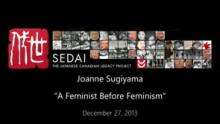
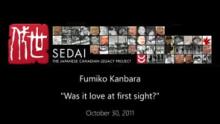
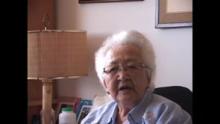

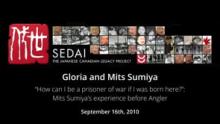
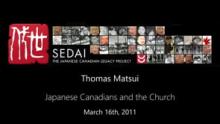

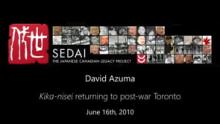
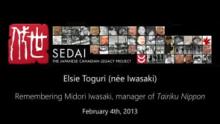
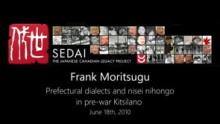
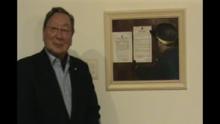


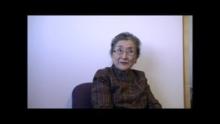
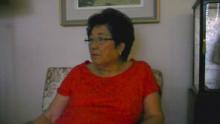
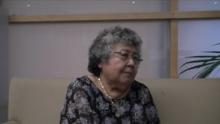
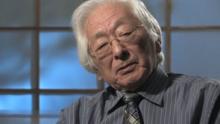
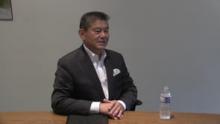
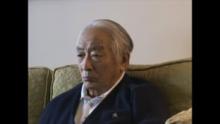
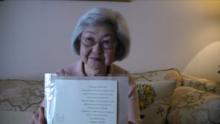
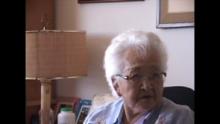

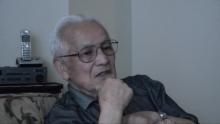

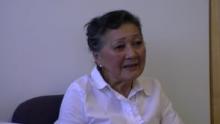
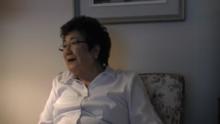
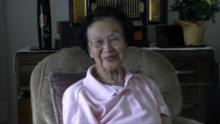

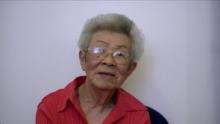
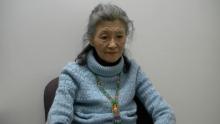
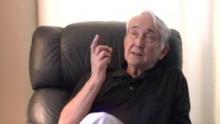
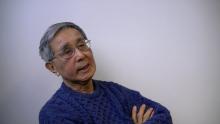
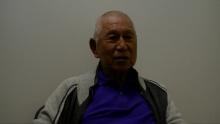

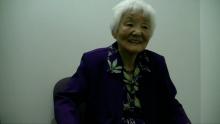
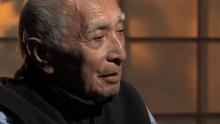
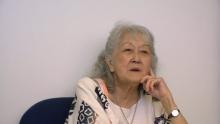
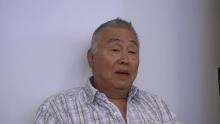
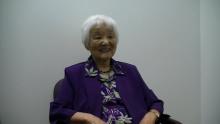
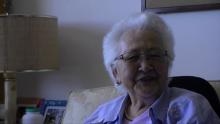

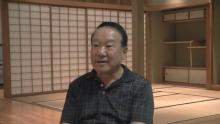
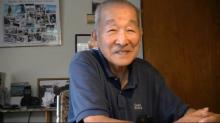
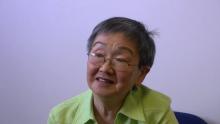
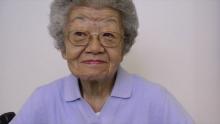
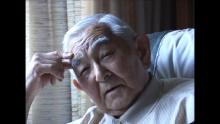
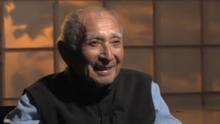

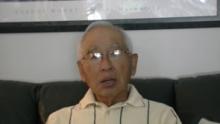
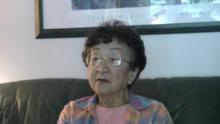
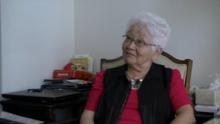

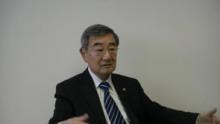

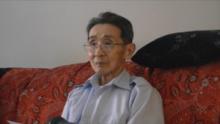
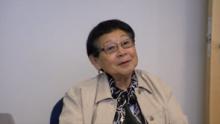
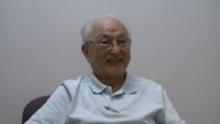
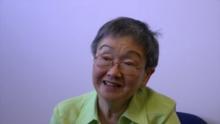

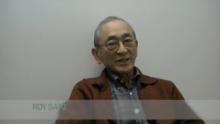
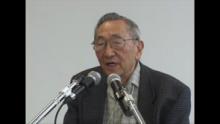
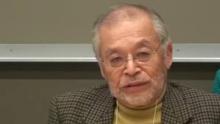
Content and Historic Language Advisory for the Sedai Oral History Collection
Sedai captures a variety of Japanese Canadian experiences. They document joy, hardship, bitterness, forgiveness, levity, and more. Of course, many experiences discussed are traumatic, particularly around forced displacement, internment, and discrimination. Sedai is privileged to preserve and steward these stories, for the education of future generations. Sedai acknowledges that these stories may be upsetting for some researchers or community members.
In addition, because of the historical nature of the interviews, the ideologies and attitudes, as well as language used in Sedai project materials may not align with the JCCC’s values. In particular, certain language related to specific marginalized groups or euphemistic language around internment, that is now outdated or offensive. Language changes over time, however it is important to preserve language in context. The JCCC strives to use appropriate language in its descriptions and internally created documentation. The inclusion of such language in historical materials does not constitute an endorsement by the JCCC. Where relevant, disclosure statements are included in individual interview catalogue entries and transcripts.
If you have questions or concerns about the content or find records that you think require our attention, please reach out to us at heritage@jccc.on.ca with the accession number or permalink to the material.
Research
- Sedai Oral History Catalogue
- Descendants of Densuke Uyede – Detailed genealogy tracing back six generations, provided in English.
- Descendants of Kannhichi Hirowatari – Detailed genealogy tracing back seven generations, provided in English and Japanese.

